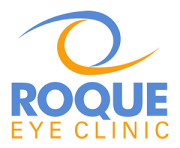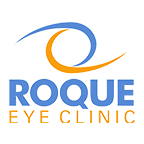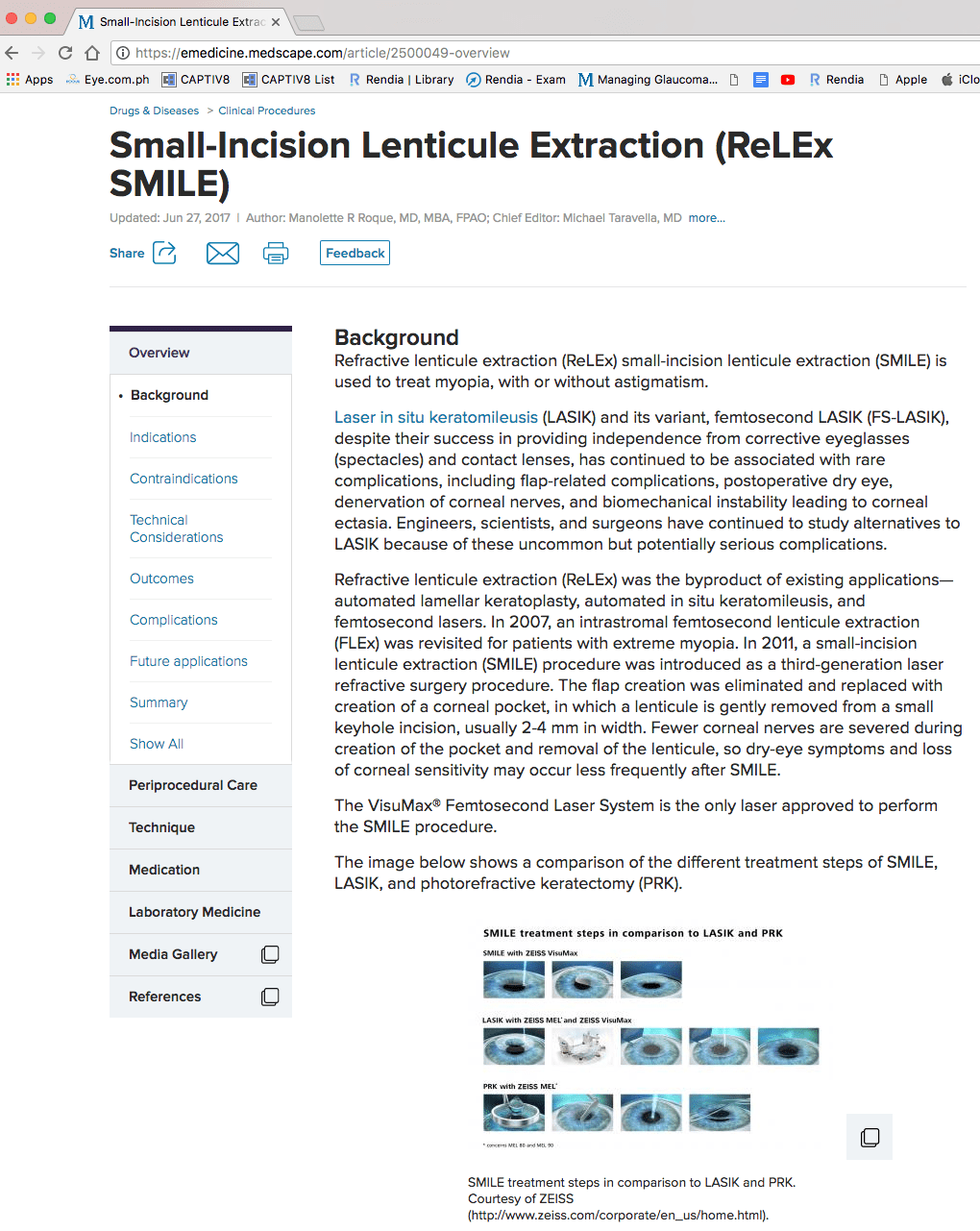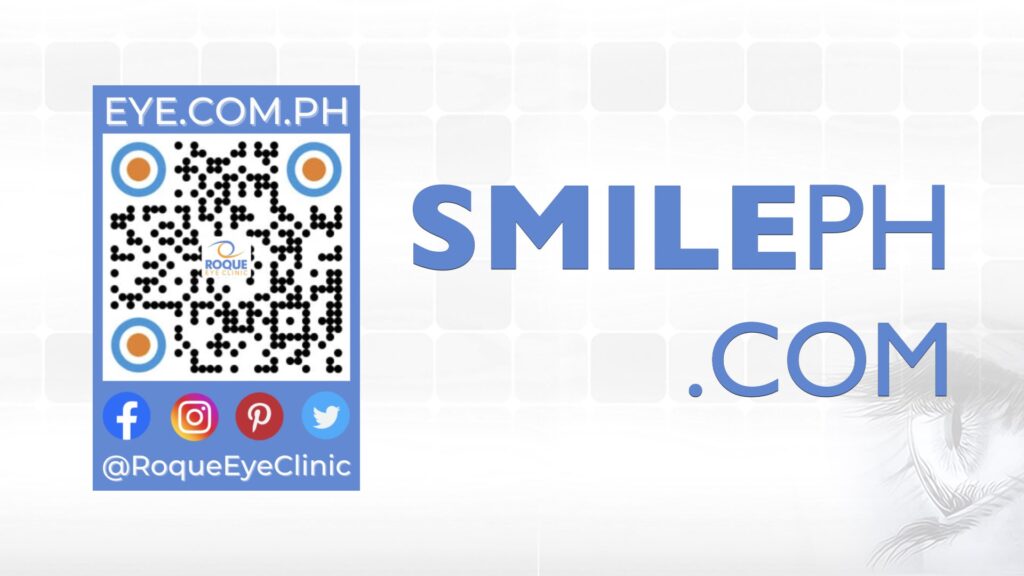
VisuMax ReLEx SMILE
We proudly offer the latest generation of premium minimally invasive laser refractive surgery procedures for patients with nearsightedness and astigmatism, VisuMax ReLEx SMILE (Small Incision Lenticule Extraction). This is a flapless, bladeless form of laser eye surgery that effectively turns laser eye surgery into a keyhole or pocket procedure. Patients with very high prescriptions, drier eyes, contact lens intolerance, and/or thinner corneas may now be qualified for surgery.
Laser refractive surgery procedures using the Excimer Laser, such as PRK (Photorefractive Keratectomy) and LASIK (Laser Assisted in-situ Keratomileusis) have been successfully performed on several millions of patients over the past two decades around the world. These procedures effectively restore spectacle-free clear vision with a few associated issues, such as delayed visual recovery, discomfort in PRK, and corneal flap complications in LASIK.
Carl Zeiss Meditec developed Refractive Lenticule Extraction (ReLEx) in the form of SMILE to address Excimer issues with the VisuMax Femtosecond laser platform.
During the procedure, eye anesthetic drops are used to numb the eye completely, and the state-of-the-art Carl Zeiss VisuMax laser places a series of pulses in the center of the cornea with extraordinary 3D placement accuracy. These pulses form bubbles that are less than 1/100th the width of a human hair and outline the tissue that needs to be removed to effectively change the cornea's shape. The laser creates a tiny connecting tunnel through which the surgeon draws out this tissue.
With ReLEx SMILE, no flap is created, so the healing time is faster than conventional LASIK. The procedure takes minutes, and the vision is 80% instantly better and reaches 100% within a few days. No other laser platform has been able to match the accuracy of the Carl Zeiss VisuMax (which is accurate enough to inscribe a word on a grain of sand) in producing this keyhole type of laser eye surgery.
SMILE QUICK LINKS
- Section 1 - Introduction
- Section 2 - What is SMILE infographic
- Section 3 - Benefits of SMILE infographic
- Section 4 - Animation and Video
- Section 5 - Screening and scheduling
- Section 6 - Estimated Timeline
- Section 7 - Comparison of Laser Vision Correction
- Section 8 - Medscape eMedicine SMILE feature
- Section 9 - Frequently Asked Questions
WHAT IS SMILE?
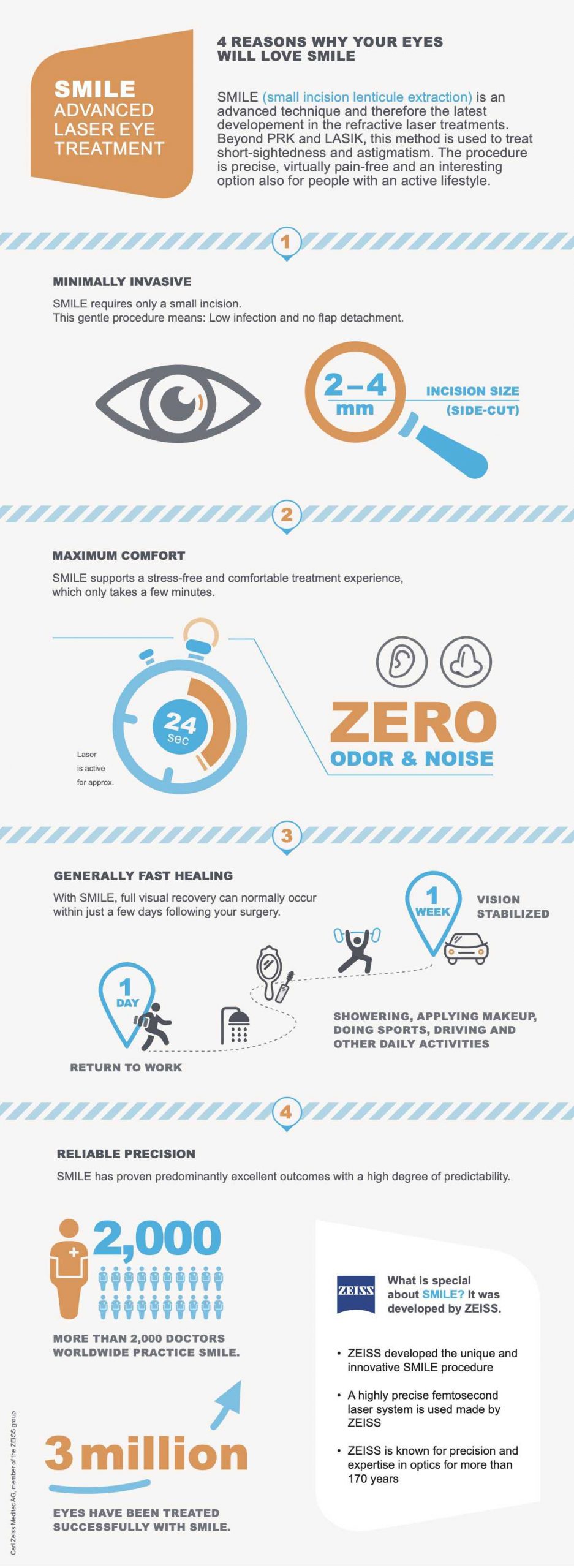
Carl Zeiss VisuMax ReLEx SMILE Advanced Laser Eye Treatment
WHAT ARE THE BENEFITS OF SMILE?
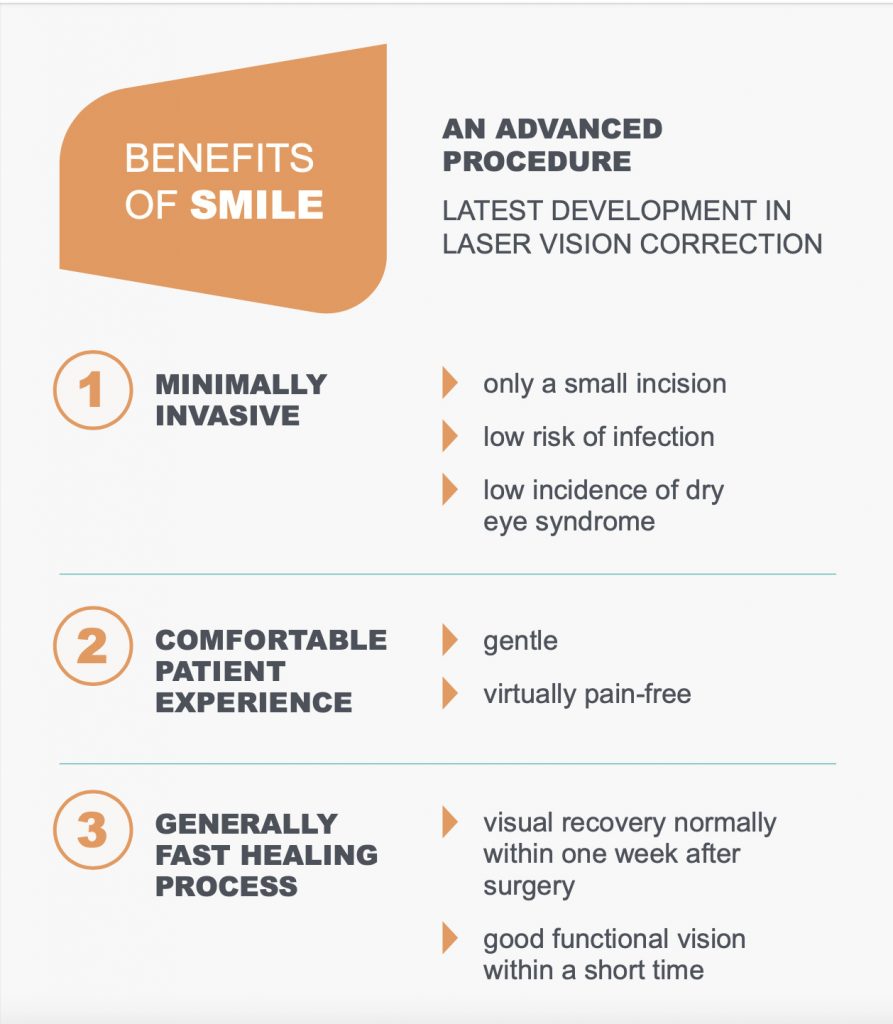
BENEFITS OF SMILE
SMILE ANIMATION & VIDEO
SMILE ANIMATION & VIDEO
Steps for SMILE laser vision correction

By adding videos and animations, we have made it easy for you to learn about SMILE laser vision correction. There is also a Comparison of Laser Vision Correction table.
Book your SMILE suitability evaluation in St. Luke's Medical Center Global City via Online Booking. Alternatively, you may call up our BGC Clinic to speak with one of our staff. SMILE suitability screening and surgery is performed in St. Luke's Medical Center Global City. It is not available in Asian Hospital and Medical Center.

Our staff will assist you with booking your refractive surgery suitability screening at the eye center. Depending on your ocular status, you may also need to have the following done: keratograph, fundus photo, OCT, B-scan, etc.

The refractive surgery suitability screening results will be evaluated by Dr. Manolette Roque during your clinic visit. The best vision correction surgery will be offered based on your vision requirements, ocular status, and budget.

Once you have decided to proceed with SMILE laser vision correction, you may pick the nearest available surgical slot, at your convenience.
ESTIMATED TIMELINE
At least one week before SMILE screening.SMILE SCREENING INSTRUCTIONS
SOFT CONTACT LENS HOLIDAY
Soft contact lens (SCL) users are required to discontinue the use of SCLs for at least one (1) week before the refractive screening. Hard contact lens and Rigid Gas Permeable (RGP) users are required to discontinue the use of RGPs for at least four (4) weeks before the refractive screening. Contact lens holidays allow the surface of the cornea to recover to its natural state, thereby increasing the reliability of the results of the diagnostic screening. Kindly wear your prescription eye glasses during this contact lens holiday. Please coordinate closely with our staff if you wish to move the tests to an earlier or later date.
OCULAR LUBRICATION
Kindly apply over-the-counter preservative-free lubricating drops hourly to both eyes during waking hours for at least 1 week prior to the surgery. This will make you feel comfortable with instilling topical medication to your eyes after surgery.
At least one week after soft contact lens holiday.SMILE SUITABILITY SCREENING
SMILE SUITABILITY SCREENING
After complying with your refractive surgery pre-screening instructions, you are now ready to proceed with your VisuMax ReLEx SMILE screening. It usually takes an average of three (3) hours to complete a refractive surgery screening. Your eyes will remain dilated for 6-8 hours after the procedure, therefore it is recommended that you don't schedule anything important for the rest of the day. After reporting to our clinic, our staff will escort you to the laser diagnostic room where the process will begin.
OCULAR HISTORY AND EXAMINATION
PERSONAL INFORMATION
Your personal information will be logged into the hospital records.
CLINICAL HISTORY
Clinical history taking will be performed. Your ophthalmic history, medical history, and family history will be reviewed. Please take note of all the medications that you are currently taking.
PRESCRIPTION GLASSES
Please hand over all of your prescription eyeglasses so our optometrist can record the power.
VISION AND REFRACTION
Your visual acuity will be taken with and without your current prescription eyeglasses. Automated refraction, manual/manifest refraction, and dilated/cycloplegic refraction will be done. All these measurements are critical in determining your best potential visual acuity.
SLIT LAMP BIOMICROSCOPY
Your eyelids, eyelashes, and the anterior segment (conjunctiva, cornea, pupil, iris, and lens) of your eye will be examined with a slit beam of light. This examination is performed to search for lid and lash conditions, corneal diseases, pupil and iris abnormalities, and lens status.
OCULAR SURFACE EVALUATION
Fluorescein dye applied to your eye will be used to examine the ocular surface for signs of dry eye disease. Your tear break-up time (TBUT) will be measured. In some instances, the use of a Rose Bengal or Lissamine Green dye strip may be necessary.
APPLANATION TONOMETRY (Haag Streit Goldmann)
A topical anesthetic, proparacaine, will be instilled into your lower eyelid pocket in order to numb your eye. A fluorescein dye and a cobalt blue filter will be used to measure your ocular pressure. Your eye pressure will be correlated with your corneal thickness. This examination is used to screen for glaucoma.
OCULAR DIAGNOSTIC TESTS
PUPILLOMETRY (Oasis Medical Colvard)
An infrared pupillometer will be used in a dark room to check for pupil size at night. This will assist us in selecting an appropriate optical zone for the best night vision. This examination is performed prior to pupil dilation.
OPTICAL BIOMETRY (Zeiss IOL Master)
Your ophthalmic 'time capsule' will be taken to secure your pre-refractive surgery corneal curvature and eyeball length. This will be useful once you have cataract surgery in the future. This examination is performed prior to pupil dilation.
SPECULAR MICROSCOPY (Topcon)
This measures endothelial cell density (ECD). Low ECD is a risk factor for refractive (corneal and cataract) surgeries that can be missed without the use of a specular microscope. This examination is performed prior to pupil dilation.
CORNEAL TOPOGRAPHY (Zeiss Atlas Pathfinder)
The corneal curvature is measured using this diagnostic test. It will show the flat and steep areas of your cornea. This helps in screening for keratoconus, which is a contraindication to laser refractive laser surgery. This examination is performed prior to pupil dilation.
SCHEIMPFLUG ANALYZER (Oculus Pentacam)
This is an improved version of a corneal topographer. It has the benefit of giving refractive surgeons more information on the curvature and thickness of the cornea. It is very useful in identifying even early keratoconus. This examination is performed prior to pupil dilation.
ABERROMETER (Zeiss WASCA)
Think of this as a super automated refraction machine. Traditionally, our refractive errors are determined using an autorefractor, phoropter, or trial lens. These are able to determine the amount of myopia, hyperopia, and astigmatism. However, our eyes as an optical system have higher wavefront measurements that are of consequence to the quality of our vision. The wavefront aberrometer measures how a wavefront of light passes through the cornea and the crystalline lens, which are refractive components of the eye. Distortions that occur as light travels through the eye are called aberrations, representing specific vision errors. This examination is performed before and after pupil dilation.
OCT MACULA (Zeiss Cirrus OCT )
A special photo of the macula is taken with this machine. The macula is responsible for the central 30 degrees of functional vision. So, a fully functioning macula will allow us to see the face of an individual who we are looking at. If this is diseased, we will see a central obstruction in vision. This examination is performed before or after pupil dilation.
OCT OPTIC NERVE (Zeiss Cirrus OCT)
A special photo of the optic nerve is taken with this machine. The optic nerve may be damaged because of glaucoma. Early detection is possible with this diagnostic test. This examination is performed before or after pupil dilation.
DILATED FUNDUS EXAMINATION
Dilating ophthalmic drops will be instilled into your lower eyelid to make your pupils dilate. It usually takes around 30 minutes to achieve full pharmacologic pupillary dilation. Dilation will allow us to examine your retina for congenital/acquired posterior segment diseases. We can see retinal tears/holes, macular degeneration, and optic nerve diseases, among other things. The presence of any posterior segment condition may disqualify one from having refractive laser surgery. Dr. Roque performs this at the end of the refractive surgery screening process.
REFRACTIVE COUNSELING
Dr. Roque will evaluate the results of your refractive surgery screening and determine if your eyes are fit to undergo refractive surgery. At this time, you will be able to ask all your questions about the possible surgical options. If you are accompanied by a decision-maker prior to surgery, you may have this person join you for this session.
This is the day.SMILE SURGERY DAY
SMILE Surgery Day
You have completed your refractive surgery screening and have been found to be an excellent candidate for refractive surgery. These are general guidelines for you to remember on the day of surgery.
- We suggest that you sleep early the night before surgery.
- We require no diet restriction prior to the surgery. You may have your regular meals up to 2 hours before surgery. You may have a complete meal immediately after surgery.
- Please arrange for someone to be with you after surgery. You may only be released to a responsible adult.
- On the day of surgery, please shampoo your hair and take a full body bath. We want you to feel fresh and clean.
- Wear something warm and comfortable. The laser room is very cold.
- Do not apply any eye and facial makeup. Do not apply any hair gel. Do not spray on any perfume.
- Please arrive at the St. Luke's Medical Center Global City Vision Laser Center 1 hour prior to surgery. This will give our laser room staff adequate time to assist you. It will also provide you sufficient time to relax before your pre-operative preparation 30 minutes before surgery.
- Kindly keep the rest of your day free.
- If you have any questions or are uncomfortable about your surgery, please call +639178442020 or +639989982020 before the surgery date.
Congratulations. You just had SMILE laser vision correction.SMILE POST-OPERATIVE INSTRUCTIONS
SMILE POST-OPERATIVE INSTRUCTIONS
General guidelines:
- DO NOT rub your operative eye or squeeze your eyelids tightly immediately following your procedure.
- Wear the protective goggles at bedtime or naptime for seven days following ReLEx SMILE surgery.
- Use your best judgment when exercising. We strongly recommend headbands for seven-day sweat control and goggles for contact sports for up to a month.
- It is ok to shower or bathe; however, avoid getting water into your eyes for two weeks after surgery.
- Avoid smoky or dusty rooms or areas with chemical vapors for two weeks following ReLEx SMILE surgery.
- DO NOT wear make-up or apply lotion around the eyes for two weeks following ReLEx SMILE surgery.
- DO NOT swim or dive in pools or the ocean for one month after surgery.
- Some eye drops may sting for up to 2 minutes or cause temporary blurred vision.
- DO NOT drive unless you feel safe and confident with your vision.
Surgical discomfort: Use the medication as prescribed by Dr. Manolette Roque.
Diet: Regular diet on the day of surgery.
EYE DROPS
How to use eye drops:
- Wash your hands before administration of eye drop medications.
- DO NOT touch the eye dropper or let the dropper touch your eye.
- Shake the eye drops well before using.
- Tilt your head back, gazing upward, and pull down on your lower eyelid, making a pouch.
- Place the dropper directly over the eye and administer a prescribed number of drops.
- Look downward and gently close your eyes for 1 or 2 minutes.
- Try not to blink or rub your eyes.
- DO NOT rinse the eye dropper.
- WAIT 5 minutes between every new type of eye drop medication administered.
Report any of the following to your doctor:
- Uncontrollable nausea or vomiting
- Worsening vision
- Development of rash
- Excessive pain, not relieved by pain relievers
For Emergencies: Call us at St. Luke's Medical Center Global City MAB 217 at +639178442020 or +639989982020 from 8 am-5 pm, Mondays to Saturdays. After clinic hours, please proceed to the St. Luke's Medical Center Global City Emergency Room. We have Board-certified ophthalmologists on duty to evaluate and assist you. They will call up and update Dr. Manolette Roque.
COMPARISON OF LASER VISION CORRECTION
| SMILE | LASIK | PRESBYOND | PRK | |
|---|---|---|---|---|
| LASER REFRACTIVE SURGERY | Refractive Lenticule Extraction - Small Incision Lenticule Extraction | Femtosecond Laser-Assisted In Situ Keratomileusis | Femtosecond Laser-Assisted In Situ Keratomileusis | Photorefractive Keratectomy |
| A.K.A. | SMILE, bladeless flapless laser refractive surgery; pocket laser refractive surgery; beyond LASIK; MILE | FS-LASIK, bladeless LASIK, all-laser LASIK | PRESBYOND laser blended vision, LBV | LASEK, ASA, advanced surface ablation, advanced surface treatment |
| GENERATION | 3rd Generation (bladeless, flapless) | 2nd Generation (bladeless) | 2nd Generation UPDATE (bladeless) | 1st Generation (surface) |
| REFRACTIVE SUITE | VisuMax 500 | VisuMax 500 + MEL90 | VisuMax 500 + MEL90 | MEL90 |
| LOCATION | St Luke's BGC | St Luke's BGC | St Luke's BGC | St Luke's BGC |
| CONSULT DR. MANOLETTE ROQUE | Book now | Book now | Book now | Book now |
|
SOFT CONTACT LENS HOLIDAY |
One week | One week | One week | One week |
| COST OF SUITABILITY EXAMS (PHILIPPINE PESOS) |
||||
| REFRACTIVE SCREENING | 5,414 | 5,414 | 5,414 | 5,414 |
| DRY EYE PACKAGE | 3,936 | 3,936 | 3,936 | 3,936 |
| COLOR FUNDUS PHOTOS (OPTOS OR CLARUS) | 1,244 | 1,244 | 1,244 | 1,244 |
| OCT MACULA | 5,664 | 5,664 | 5,664 | 5,664 |
| OCT OPTIC NERVE | 5,664 | 5,664 | 5,664 | 5,664 |
| SAME-DAY SCREENING & SURGERY | Possible (not recommended) | Possible (not recommended) | Possible (not recommended) | Possible (not recommended) |
| LASER VISION CORRECTION | SMILE | LASIK | PRESBYOND | PRK |
| LVC PACKAGE | 131,175 | 78,000 | PROMO 78,000 | 50,960 |
| BLADELESS | Yes | Yes | Yes | Yes |
| FLAPLESS | Yes | No | No | Yes |
| INDICATION | ||||
|
MYOPIA (NEARSIGHTEDNESS) SPHERE UP TO -11.0 D |
Yes | Yes | Yes | Yes |
|
ASTIGMATISM CYLINDER UP TO -5.0 D |
Yes | Yes | Yes | Yes |
|
HYPEROPIA (FARSIGHTEDNESS) SPHERE UP TO +3.0 D |
No | Yes | Yes | Yes |
| PRESBYOPIA (VISION AFTER AGE 40) | No | No | Yes | No |
| LASER BLENDED VISION | No | No | Yes | No |
| READING GLASSES AFTER AGE 40 | Yes | Yes | No | Yes |
| POST-OP VISITS | SMILE | LASIK | PRESBYOND | PRK |
| RECOMMENDED (IDEAL) | Day 1; Week 1; Month 3 | Day 1; Week 1; Month 3 | Day 1; Week 1; Months 3 and 6 | Day 1; Week 1; Month 3 |
| REQUIRED (MINIMUM) | Day 1; Week 1 | Day 1, Week 1 | Day 1; Week 1; Month 6 | Day 1; Week 1; Month 3 |
| LIMITED WARRANTY | Included | Included | Included | Included |
| EPITHELIAL ABRASION | No | No | No | 8-10 mm |
| CORNEAL INCISION LENGTH | 4 mm | 20 mm | 20 mm | None |
| BANDAGE CONTACT LENS | No | No | No | Yes |
| DISCOMFORT | One day | One day | One day | One week |
| DOWNTIME | One to three days | One to three days | One to three days | One week to one month |
| HAZE | One day to one week | No | No | One to three months |
| DRY EYE SYMPTOMS | Mild, transient; three months to one year | Mild, transient; three months to one year | Mild, transient; three months to one year | Mild, transient; three months to one year |
| RESTRICTION | SMILE | LASIK | PRESBYOND | PRK |
| LIGHT EXERCISE | One week | One week | One week | One week |
| SWIMMING, DIVING, HEAVY EXERCISE, CONTACT SPORTS | One month | One month | One month | One month |
| POST-OP MEDICATIONS | at least one week | at least one week | at least one week | One to three months |
| SPORTS SAFETY | Yes | No | No | Yes |
| NEUROADAPTATION | ||||
| DISTANCE - DAY | Three days to one week | One day to one week | One week | One week to one month |
| INTERMEDIATE & NEAR | One week to one month | One day to one week | One week to one month | One month to three months |
| DISTANCE - NIGHT | One month to three months | One week to one month | One week to six months | Three months |
| DISTANCE VISION OUTCOMES AT THREE MONTHS | ||||
| UCVA 20/40 | almost 100% | almost 100% | almost 98% | almost 100% |
| UCVA 20/20 | at least 90% | at least 90% | at least 88% | at least 90% |
SMILE FEATURE
eMedicine Medscape ReLEx SMILE
FREQUENTLY ASKED QUESTIONS
SMILE FAQs
Wear the eye shield for a week. After surgery, wear the eye shield before bedtime and before napping to prevent any unconscious rubbing.
Artificial tears can be administered as frequently as needed to prevent dry eye symptoms. Use artificial tears for at least three months.
Patients can wash with warm (not hot) water the day after their SMILE procedure. Avoid getting soap, shampoo, or other irritants in your eyes when taking a shower.
SMILE's recovery time is usually faster than PRK, with many patients experiencing good vision within a few days. Makeup application guidelines after SMILE surgery are similar to LASIK, and it is generally advised to wait at least a week before using eye makeup. Facial makeup application is permitted but not eye makeup for one week after surgery.
After surgery, refrain from exercise during the first week to prevent sweat from getting into the eye.
Refrain from swimming and diving for one (1) month after surgery. One month after the surgery, you can go swimming and diving. However, it is recommended to avoid opening your eyes under water both in pools and the ocean. Chlorinated water in swimming pools can irritate your sensitive eyes during the recovery period and the ocean carry high levels of infection-causing bacteria. Therefore, you should wear protective goggles when swimming.
With SMILE laser vision correction, as with any surgical operation, patients must take some post-operative measures to promote good healing and recovery. One of the patients’ frequently asked questions is when they can travel following SMILE eye surgery.
The patient and their recovery process ultimately determine the answer to this question. Before traveling, patients should generally wait at least a week following SMILE eye surgery. You can fly after the surgery. Your eyes will get dry easily on the plane because airplanes are dry forced-air environments so it is recommended to lubricate your eyes frequently with artificial tears to aid healing. Fluctuations in air pressure during takeoff and landing can be uncomfortable and harmful to the eye while it recovers.
It should be noted, however, that each patient’s recovery is unique and may be impacted by factors such as the degree of the operation and the individual’s overall health. Before traveling following SMILE eye surgery, patients should always speak with their ophthalmologist.
You should wear your sunglasses anytime you go outside especially in bright daytime light, dusty or windy areas.
You can resume normal activities including working at the computer and reading. Expect some minor discomfort for the first three days.
BOOK AN APPOINTMENT
It takes less than 5 minutes to complete your online booking. Alternatively, you may call our BGC Clinic, or our Alabang Clinic for assistance.
